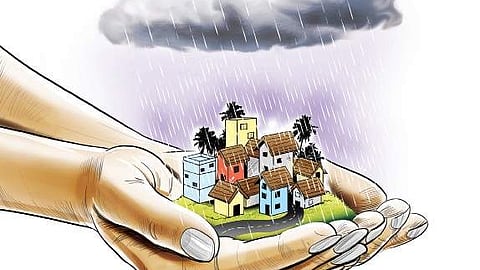

Every time there is a water crisis, figures are dished out to emphasize how bad the situation is. Its impact is highlighted. The suffering of people comes under the spotlights. Cases are pointed out wherein families are planning to shift their homes to another city, town or village where the water situation does not threaten their survival. The ruling disposition and the opposition find it a weapon to have a go at each other to impress upon the electorate. It becomes a narrative more than a serious problem – which it is – needing long-lasting solutions.
The meteorological department has forecast rain any time now. One of the solutions that citizens can have a direct crack at is rainwater harvesting. Unfortunately, not just in Karnataka, but across India, rainwater harvesting has a poor record to show. The country receives an average annual rainfall of 1,180 mm, according to annual data from the meteorological department. But only about 8% of rainwater is harvested, although it holds much promise for each household. It is estimated that rainwater harvesting can meet up to 70% of the water needs of each household.
Bangalore Water Supply & Sewerage Board (BWSSB) estimates show the total water availability potential for Bengaluru is 1,550 million litres per day (MLD). The water requirement is 1,600 MLD, but the water received is 1,450 MLD — a deficit of 150 MLD. The World Health Organization (WHO) says the requirement should be 135 litres per capita per day (LPCD), but the availability of water in Bengaluru is 100-120 LPCD.
According to the BWSSB, the city is endowed with very good rainfall. It is estimated that even if 50% of the rainfall is harvested, it will provide an additional 10-15 thousand million cubic feet (tmcft) of water. Which is why BWSSB made it mandatory for installation of rainwater harvesting systems on every building with a site area measuring 60’X40’ and above, and for newly constructed buildings measuring 30’X40’ and above in dimensions.
BWSSB claims to have made efforts to promote rainwater harvesting across the city. Its website boasts of having imparted training to plumbers, contractors and others for execution of rainwater harvesting methods in scientific manner, besides scientific demonstrations at Karnataka State Council for Science and Technology in the Indian Institute of Science, where over 1,000 persons have been trained in 46 training sessions. Sixty-days’ Abhiyana programmes have been conducted for early morning walkers in Lalbagh, Cubbon Park and open areas along with street plays in the presence of local elected representatives. These also included talks and interactions with rainwater harvesting experts and BWSSB officials. At least 21 such Abhiyana programmes are said to have been conducted.
BWSSB has taken initiatives to install rainwater harvesting systems even at CM’s home office, Vidhana Soudha, Vikasa Soudha, Raj Bhavan, MS Building and Cauvery Bhavan, among others, besides in its own structures.
And yet, a city like Bengaluru — which is now being threatened with a predicament similar to that of a water-less Cape Town in South Africa — records just one-fifth of the households having installed rainwater harvesting systems. Evidently, although awareness about the benefits of rainwater harvesting is spreading, there appears to be a degree of unwillingness (or even inability) to install the systems. Water experts, scientists and BWSSB engineers need to connect more directly with people in training them, encouraging them and assisting them in installing the systems. This needs to be accompanied by incentives to encourage more people to follow suit. The benefits of these efforts will speak for themselves.
There have been shining examples of people installing the systems and accruing benefits from it. Sixty-two-year-old Michael Baptist in 2021 launched the Farmland RainWater Harvesting Systems (FLRWHS) in Chikkamagalur which has significantly helped farmers and people of that region. In Gendathur, a remote backward village in Mysuru, nearly 200 households have installed rainwater harvesting systems. Noted water expert S Vishwanath has acknowledged that the rainwater harvesting system installed at his energy efficient house in Vidyaranyapura continues to supply water it collected the last time it rained in November.
We need to learn to trap rainwater… and save it for a rainy day. We need to take on the role of “rainwater custodians” to ensure that no water stress in the future affects our lives. It is possible. It can be done. But there needs to be a will to accomplish it.
Nirad Mudur
Deputy Resident Editor, Karnataka
niradgmudur@newindianexpress.com